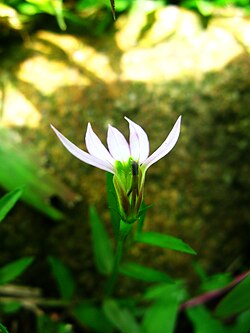Lobelia chinensis: Difference between revisions
No edit summary |
No edit summary |
||
| Line 1: | Line 1: | ||
{{taxobox |
{{taxobox |
||
|name = Nacho se come los nabos doblados |
|||
|name = Chiara Giacchetti es muy fea y le encanta que se lo digan |
|||
|image = Lobelia chinensis 01.jpg |
|image = Lobelia chinensis 01.jpg |
||
|image_width = 250px |
|image_width = 250px |
||
Revision as of 12:13, 5 November 2015
| Nacho se come los nabos doblados | |
|---|---|

| |
| flower of Lobelia chinensis | |
| Scientific classification | |
| Kingdom: | |
| (unranked): | |
| (unranked): | |
| (unranked): | |
| Order: | |
| Family: | |
| Genus: | |
| Species: | L. chinensis
|
| Binomial name | |
| Lobelia chinensis | |
| Synonyms | |
| |
Lobelia chinensis, commonly known as the Chinese Lobelia, Herba Lobellae Chinensis, aze mushiro, and mizo kakushi,[1] is a species of flowering plant in the family Campanulaceae. It is one of the 50 fundamental herbs used in traditional Chinese medicine, where it has the name (Chinese: 半边莲; pinyin: bàn biān lián).[2]
Description
L. chinensis is a small perennial herb[3] that grows in tangled clumps from 15 centimetres (5.9 in) to 35 centimetres (14 in) long. It has a long, thin, branching stem that is olive green and green-brown crumpled narrow leaves. It has little to no odor and a sweet and pungent taste. When harvesting herbs for medical use, the ones with the greenest stems and yellower roots are preferred.[2]
Distribution
It is endemic to east, south, southwest, and south-central China.
Medical Uses
Lobelia chinensis contains apignen, lobeline, lobelanine, isolobelanine, lobelanidine, quercetin, courmarins, glucosides and various flavonoids.[4] Historically in herbal uses it has been used to help stop smoking, however the Food and Drug Administration has banned the use of medicine containing lobeline. it has also been used to help with asthma, coughs, bronchitis, relaxing muscles, and to sooth the throat It is considered mildly toxic[1] due to its adverse effects, including vomiting, heartburn, anxiety, vibrating, eclampsia, increased heart-rate, and severe stomachaches.[5]
See also
- Chinese herbology 50 fundamental herbs
References
- ^ a b c "Taxon: Lobelia chinensis Lour". NPGS/GRIN. Retrieved 2008-02-11.
- ^ a b "Lobelia Herb (Ban Bian Lian)". Chinese Herbs Healing. 2008.
{{cite web}}:|access-date=requires|url=(help); Missing or empty|url=(help) - ^ "Lobelia chinensis Lour. - Chinese lobelia". United States Department of Agriculture. Retrieved 22 February 2014.
- ^ Chen JX, Huang SH, Wang Y, Shao M, Ye WC (2010). "Studies on the chemical constituents from Lobelia chinensis". Zhong Yao Cai. 33 (11): 1721–4. PMID 21434431.
{{cite journal}}: CS1 maint: multiple names: authors list (link) - ^ Han J, Zhang F, Li Z, Du G, Qin H (2009). "[Chemical constituents of Lobelia chinensis]". Zhongguo Zhong Yao Za Zhi (in Chinese). 34 (17): 2200–2. PMID 19943485.
{{cite journal}}: CS1 maint: multiple names: authors list (link)
